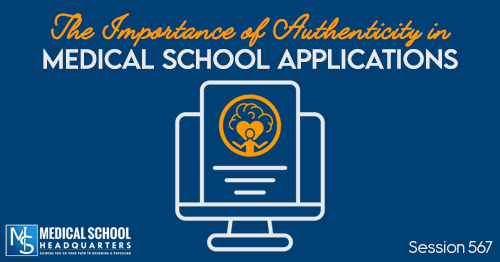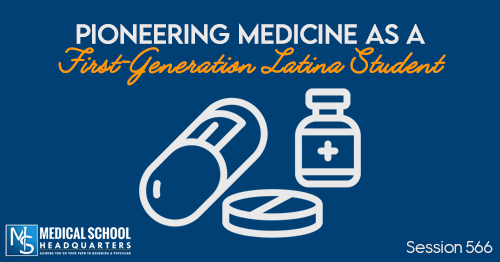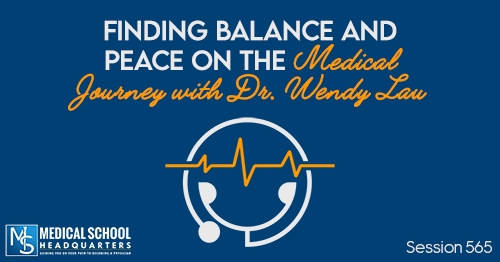Apple Podcasts | Google Podcasts
Session 538
Recent med school grad, Tricia, makes the argument that students should use match lists when building their school lists. Follow Tricia on TikTok @triciapendergrastmd.
For more podcast resources to help you with your medical school journey and beyond, check out Meded Media.
Listen to this podcast episode with the player above, or keep reading for the highlights and takeaway points.
[00:36] The MCAT Minute
The MCAT Minute is brought to you by Blueprint MCAT.
Did you know one of the best ways to prepare for the MCAT is by taking practice exams? By signing up for a free account over a Blueprint MCAT, you get a half-length diagnostic and a free full-length, as well as other great tools to help you get the score that you need.
[02:13] Her Interest in Becoming a Physician
Tricia’s journey to becoming a doctor was a unique one. Initially unsure of her career path, she explored different fields such as athletic training and psychology. However, it was an on-field emergency that she addressed as an athletic trainer that made her realize her passion for patient care. Encouraged by someone who read her personal statement, Tricia recognized her desire to be involved in the medical field.
With her father being a retired flight paramedic, Tricia grew up fascinated by the medical world. She recalls watching helicopters land in their rural Illinois backyard for dispatch tests, which further ignited her interest. Before committing to medical school, she conducted thorough research and sought advice from those already pursuing a medical career.
“Before you commit yourself to this pathway before you choose medicine, be sure it's what you truly want to do.” Click To TweetTricia took a non-traditional path, starting medical school at the age of 25. This allowed her more time to explore her options and make an informed decision. Her journey exemplifies the importance of taking the time to fully understand and research a chosen career path before wholeheartedly committing to it.
[06:55] The Reality and Challenges Faced by Medical Professionals
The Struggle to Be Heard: Challenging the Status Quo in Medicine
In the field of medicine, there has long been a romanticized perception of the profession as a calling. However, when individuals attempt to voice concerns or advocate for themselves, they are often met with resistance.
This mentality of “get in line, know your role” has permeated the medical world, particularly among med students and residents.
The strict hierarchy and authoritative nature of medicine can be traced back to its origins. The residency system was initially designed to exploit the labor of residents, providing support to surgeons who were under the influence of substances. Unfortunately, this hierarchical structure has persisted largely unchallenged throughout the decades, and in some cases, it has become even more stringent.
Unveiling the Hidden Realities: Breaking the Illusion of the Glamorized Medical World
Another contributing factor to this mentality is the romanticized portrayal of the medical field in popular culture. Movies, TV shows, and even social media platforms like TikTok often depict a glamorous and picture-perfect image of the profession. However, behind the scenes, many medical students and residents battle with mental health challenges such as depression and anxiety. They sacrifice time with their families and endure long hours without adequate compensation for their efforts.
It is crucial to shed light on the realities and challenges faced by medical professionals. By sharing her experiences and creating videos on TikTok, the speaker aims to demystify the profession and provide pre-med students with a realistic understanding of what they may encounter. It is essential for the medical community to take on the responsibility of accurately representing the field, ensuring that aspiring medical professionals are well-informed before embarking on their journey.
[11:43] How to Choose a Medical School
Evaluating the Financial Investment: Treating Medical School Selection like Buying a House
When the choice of a medical school and investing in medical education, it is crucial to view it as a significant financial investment. Similar to buying a house, where you carefully evaluate the location, amenities, and condition of the property before making a purchase, it is important to approach medical school selection with a similar mindset.
Tricia emphasizes the analogy of buying a house to highlight the importance of conducting thorough research and due diligence. Just as a seller is legally obligated to disclose any issues or faults with a house, medical schools should also provide transparent information about their match data and other aspects of their program. Unfortunately, there is currently a lack of mechanisms to ensure open and honest reporting from medical schools.
Bridging the Transparency Gap: The Need for Open and Honest Reporting in Medical School Admissions
While accreditation bodies such as the LCME and COCA exist to assess and accredit medical schools, they may not have a comprehensive system in place to verify match data and other critical information that prospective students need to make informed decisions.
Tricia’s advice underscores the need for increased transparency and accountability within the medical education system. Aspiring medical students deserve access to accurate and reliable information to guide their decision-making process and ensure that their investment of time and money leads to a fulfilling and successful career in medicine.
'If you cannot verify that the investment you're making financially, your time, your money, your energy, is going to be paid back. That's not a good investment.”Click To TweetAt the end of the day, Tricia emphasizes that when choosing a medical school, you have to be critical of what you’re being sold by these schools.
[14:27] What to Look for in a Match List
The Importance of Considering Match Lists in Medical School Selection
Tricia raises some valid concerns about the importance of considering match lists when choosing a medical school. It is true that many students change their minds about their desired residency specialty once they are in medical school.
Relying solely on match lists to select a school based on the specialty with the highest match rate can lead to potential disappointment if students discover new interests or preferences.
Changing Interests: A Reality for Many Medical Students
Premed students who are unsure about their desired specialty should carefully consider the range of residency programs that a medical school’s graduates have matched into. It is essential to evaluate whether the school offers a variety of opportunities in different specialties like internal medicine, family medicine, psychiatry, PIDs, plastic surgery, orthopedic surgery, and others.
Additionally, the longitudinal trajectory of these trends is vital. If a student develops a passion for a specific specialty, it is crucial to ensure that the school has a history of successfully placing students into programs relevant to that field. This consideration becomes especially important as students progress through their medical education and enter their third year, where forging their own path becomes challenging without strong mentorship and support from the institution.
Navigating Biases: MD vs. DO vs. IMG Conversations
Furthermore, Tricia mentions the MD versus DO versus IMG conversation. It is important for students to be aware of any biases or stigmas associated with different medical degrees or backgrounds. Understanding these potential biases can help students make informed decisions about their career paths and consider additional steps, such as retaking exams or gaining more research experience, to increase their chances of obtaining a residency in their desired specialty.
In summary, Tricia highlights the need for premed students to carefully evaluate match lists, considering the potential for changing interests, the range of specialties offered by the school, the historical success in placing students in desired programs, and potential biases associated with different medical degrees. Making informed decisions based on these factors can greatly contribute to a student’s success and satisfaction throughout their medical education and future career.
[20:13] Is Research Important in Residency Applications?
In the ever-evolving landscape of residency applications, the importance of research productivity among medical students is on the rise. With the recent shift to pass/fail for Step 1 of the USMLE, Tricia mentions a survey suggesting that program directors are placing greater emphasis on research accomplishments as a determining factor for selection.
Students who match into highly ranked residency programs tend to have a higher level of research productivity. But it’s also crucial to note that this correlation does not imply causation. To understand the true significance of research insights from program directors become invaluable.
[22:56] Unveiling the Realities Behind Medical School Match
Tricia offers valuable insights into the medical school match process and highlights the importance of gathering qualitative data from fourth-year students (M4s) during off-the-record conversations. She believes that speaking with M4s can provide a more accurate understanding of the match experience. They can share firsthand accounts and insights that go beyond the promotional materials presented by medical schools.
'There are a lot of scenarios that can happen in the match, that are less than optimal, that medical schools can still spin to make it seem like their students have matched.'Click To TweetAccording to Tricia, the promotional materials provided by medical schools are designed to showcase their success in matching students. However, she cautions that these materials may not always reflect the full range of scenarios that can occur during the match process.
Tricia brings attention to several less-than-optimal scenarios that can happen in the match. This includes students matching to their second-choice specialty because they dual applied. Additionally, she points out that some schools may count students taking a research year as “matched” even though they are not actively participating in the match process.
Her perspective sheds light on the need to consider these nuances when evaluating match outcomes. Tricia emphasizes the value of gathering qualitative data through conversations with current students to gain a more comprehensive understanding of the match experience.
[26:02] Understanding Attrition Rates in US MD Schools from Tricia’s Perspective
Tricia shares her thoughts on the attrition rates in US MD schools. She acknowledges that while the attrition rate is relatively low, ranging from 3% to 4%, it is still a significant number of students who do not complete their medical education.
Tricia believes that these statistics often fail to capture the full picture. There are various scenarios where students may start medical school but not finish, which are not adequately represented in the attrition rate.
For example, some students may be advised by the school to take a research year and reapply the following year if they are deemed not competitive enough. These students do not participate in the match process and are not counted towards the attrition rate, even though they are temporarily deferring their dream and forgoing one year of attending medical school.
Additionally, Tricia highlights the financial implications of deferring one’s medical education. Students who take a research year may experience a delay in their earning potential as they postpone their entry into the medical profession.
Tricia’s perspective sheds light on the complexity of attrition rates in US MD schools. While the overall attrition rate may seem relatively low, it is essential to consider the individual stories and circumstances of those who do not complete their medical education.
[32:29] The Realities of Medical School Needs and Outcomes
Discovering the Need to Learn How to Learn
Tricia reflects on the challenges of predicting one’s needs in medical school before actually experiencing it. She acknowledges that she initially believed her college study skills would seamlessly transition into medical school.
She also quickly realized that she had to learn not only a vast amount of information but also how to effectively learn and navigate the rigorous curriculum.
Finding What Benefits You in Med School
In Tricia’s opinion, the ability to adapt and change one’s interests during medical school is crucial. Students may discover new passions or areas of focus that they hadn’t anticipated, highlighting the unpredictable nature of medical education.
However, Tricia emphasizes that ultimately, matching to a residency program holds significant importance. It becomes the bottom line in determining the trajectory of a medical career.
The Importance of Location and Curriculum
Despite this, Tricia recognizes that other factors such as location and curriculum also play a role in selecting the right medical school. When comparing schools, delving into the details of these aspects can help students navigate the decision-making process.
[34:15] Navigating the Complexities of Medical Education
The Challenging Reality: Not Everyone Is Meant to Match
Within the medical education system, it becomes apparent that not everyone who enters actually belongs. Some individuals may have managed to sneak through the admissions process, only for their true colors to reveal themselves during their time in medical school.
Their lack of dedication or passion for medicine becomes evident, leading them to realize that this career path isn’t for them. And that’s perfectly fine; as long as they find happiness in other pursuits.
The Dilemma: No Right Way to Figure It Out
Determining one’s calling in the medical field is an arduous task. Students are compelled to make life-altering decisions at the tender age of 23-24 when they are still in the midst of self-discovery and shaping their identities. Even at 43, I admit I’m still on this journey of self-discovery. It’s a daunting reality to hand young, impressionable individuals a hefty debt of $300,000 and expect them to have it all figured out. Nevertheless, they are left with the challenge of forging their own paths.
“It's challenging to predict what your needs are going to be and what your interests are.”Click To TweetThe Rising Fear of Not Matching
The fear of not matching into residency programs has become a prevalent issue within the medical education system. This fear has reached such heights that students are resorting to applying to numerous programs across the country, causing confusion and astonishment among program directors.
[39:02] The Impact of Program Signals
The Benefits of Program Signals: Empowering Applicants to Express Interest
Tricia acknowledges the significance of program signals in the secondary component of residency applications. She believes that program signals provide applicants with a platform to express their interest in specific programs. That’s done by indicating them as their top favorites through a drop-down bar.
Streamlining the Application Process: How Program Signals Aid Residency Program Selection
Tricia highlights that many residency programs now utilize program signals as an initial filtering mechanism, which she finds reasonable. She understands the value of prioritizing applicants who have indicated a strong interest in a particular program. In her opinion, this approach can help streamline the application process by focusing on those applicants who have specifically identified the program as one of their top choices.
Importantly, Tricia hopes that the inclusion of program signals will positively impact the evaluation of applications. She believes that this system can potentially benefit students who may have faced challenges such as failing Step 1 on their first attempt or lacking extensive research experience.
The Limitations of Program Signals: Implications for Specialty-Specific Applications
Tricia emphasizes that applicants with outstanding personal statements or unique qualities that may have previously been overlooked without program signals now have a better chance of being recognized. However, these program signals also present inherent limitations. She uses the field of anesthesiology as an example to illustrate her point.
One of the drawbacks Tricia highlights is the restricted number of program signals available to applicants. When logging into their application, applicants are typically provided with a predetermined number of signals to allocate to their preferred programs.
For instance, an applicant may have five gold signals and ten silver signals. However, there is a strict cap on the number of programs that can be signaled, often preventing applicants from indicating interest in additional programs beyond the allocated limit.
Tricia further explains that the number of signals available varies depending on the specialty. For instance, neurology might have only three signals available, while dermatology could offer up to 25. This discrepancy poses a challenge for applicants who wish to express interest in a greater number of programs within their chosen specialty but are constrained by the limited number of signals allotted to them.
The presence of these limitations forces applicants to carefully strategize and prioritize their signaling choices, potentially overlooking programs they might genuinely be interested in due to the scarcity of available signals.
Links:
Follow Tricia on TikTok @triciapendergrastmd












